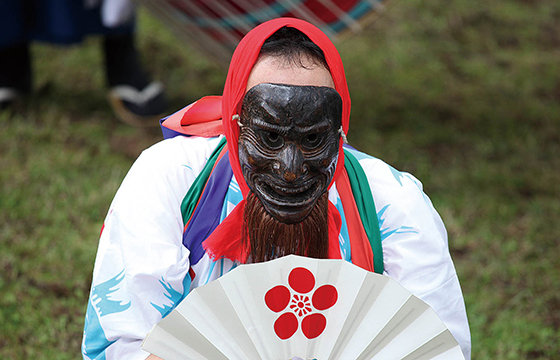
Nishi-iya Jindai Odori

The Jindai Odori (dances of the age of the gods) of Nishi-iyayama-mura retain references to the flight of the defeated Heike Warriors following the Gempel War of 1180-1185.
They are an example of the furyu style of dancing that is said to have originated during the Heian period (794-1185).
The event is a festival in which the entire village participates, both for enjoyment and to attract rain.
The dances are performed to the accompaniment of drums and are said to retain something of their old-fashioned origins, perhaps due to the remote mountain location.
They begin with the blowing of a conch shell and continue with the singing of twelve songs by a group of men in bamboo hats to the accompaniment of drums one meter in diameter.
Then dancers in decorated hats with paper strips, said to represent falling rain, form a ring and dance with fans.
The name Jindai Odori derives from the reply given to the Crown Prince (later the Showa Emperor) when he asked about the dances during a performance in the Taisho era (1912-1926): "They date from the olden days of kamiyo (the age of the gods).
The dances are an integral part of the history of the village.
They are an example of the furyu style of dancing that is said to have originated during the Heian period (794-1185).
The event is a festival in which the entire village participates, both for enjoyment and to attract rain.
The dances are performed to the accompaniment of drums and are said to retain something of their old-fashioned origins, perhaps due to the remote mountain location.
They begin with the blowing of a conch shell and continue with the singing of twelve songs by a group of men in bamboo hats to the accompaniment of drums one meter in diameter.
Then dancers in decorated hats with paper strips, said to represent falling rain, form a ring and dance with fans.
The name Jindai Odori derives from the reply given to the Crown Prince (later the Showa Emperor) when he asked about the dances during a performance in the Taisho era (1912-1926): "They date from the olden days of kamiyo (the age of the gods).
The dances are an integral part of the history of the village.
TM © Rugby World Cup Limited 2015. All rights reserved.
)